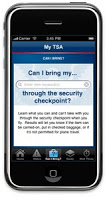TSA’s mission of keeping the traveling public safe is carried out at more than 450 airports across the U.S. and its territories. A large part of keeping the public safe includes using the best technology available. Some of the screening technologies use X-ray technology, such as backscatter imaging technology, multi-view advanced technology X-rays, explosive detection systems, and single projection X-ray systems to screen baggage. TSA has implemented stringent safety protocols to ensure the technology used at airports is safe.
While these machines improve our ability to stay ahead of threats to aviation security, it’s also important that we’re doing everything we can to ensure our technology is safe for passengers and our officers.
How do we do this? Well, in addition to radiation testing of the machine before it leaves the factory, and again once it is installed at an airport, TSA requires manufacturers and/or third party maintenance providers to test each machine routinely to make sure the radiation emitted falls within applicable standards. Additionally, radiation tests are performed after any maintenance that could impact the X-ray emissions and if the unit is ever relocated from its initial installation position.
By conducting ongoing radiation tests throughout the life of the technology, TSA is going above and beyond regulatory standards to ensure passengers and operators are not being exposed to excessive radiation doses.
As we prepared to take this step, and to verify our safety procedures, TSA recently selected 15 airports of varying sizes and reviewed reports generated from testing X-ray technologies at these airports over the last two years. You can also find all of those reports here.
The reports confirm that each piece of technology included in the review operated well-within applicable the national safety standards.
TSA did not alter or edit the reports. Names were redacted to protect privacy and several pages were incorrectly marked as SSI, but other than that, the reports are there, warts and all.
Warts? Well, while looking over these reports, we found some inaccuracies in contractor reporting that affected the documentation of some of the test results.
- Lack of notation for the latest calibration date for the machine being tested or the most recent calibration date noted had expired on survey meters
- Information missing regarding warning labels and other required labels on machines
- Calculation errors not impacting safety
- Missing survey point readings (e.g., If the test procedure required 13 points around the machine to be tested, in some cases, readings for only 11 points were reported)
- Inconsistent responses to survey questions
- No reading of background radiation noted
- Missing other non-measurement related information
While these inaccuracies didn’t impact the overall assessment that the technology is safe, they are still unacceptable. We took immediate steps to hold contractors accountable and fix the mistakes, and are taking additional measures to build on the robust safety protocols currently in place, by:
- Requiring re-testing of all backscatter advanced imaging technology units in airports, as well as all technology with inaccurate reports, by the end of March 2011;
- Requiring contractors to re-train personnel involved in conducting and overseeing the radiation survey process;
- Requesting the National Institute for Occupational Safety and Health (NIOSH) re-evaluate TSA’s safety program and update its 2008 report;
- Expanding an existing partnership with the U.S. Army Public Health Command to conduct additional independent radiation surveys and radiation safety compliance audits at airports equipped with X-ray based technologies;
- Increasing TSA oversight on the overall radiation survey and documentation process; and
- Ensuring all appropriate contractual remedies are considered and implemented, as necessary, in the event that radiation inspections are incomplete or delinquent.
- Also, every machine using X-ray technology that is deployed in an airport will have a new radiation test conducted within the next 12 months.
- Administrator Pistole has also directed TSA to commission an independent entity to evaluate these protocols.
- To provide additional transparency, TSA is posting all reports currently being conducted – and, as I said above, all future radiation reports – at www.tsa.gov as they’re completed.
To put things in perspective, here are some sources of radiation you may not have been aware of:
- One year of naturally occurring background radiation: 300 millirem
- Annual recommended limit to the public of radiation from man-made sources: 100 millirem
- Chest X-ray: 10 millirem
- Flight from New York to Los Angeles: 4 millirem
- One day of natural background:
0.1 approximately 1 millirem (corrected 3/16/11 20:56)
- Drinking three glasses of water a day for a year: 0.045 millirem
- One backscatter X-ray scan: Approximately 0.005 millirem
Blogger Bob
TSA Blog Team
If you’d like to comment on an unrelated topic you can do so in our Off Topic Comments post. You can also view our blog post archives or search our blog to find a related topic to comment in. If you have a travel related issue or question that needs an immediate answer, you can contact a Customer Support Manager at the airport you traveled, or will be traveling through by using Talk to TSA.



